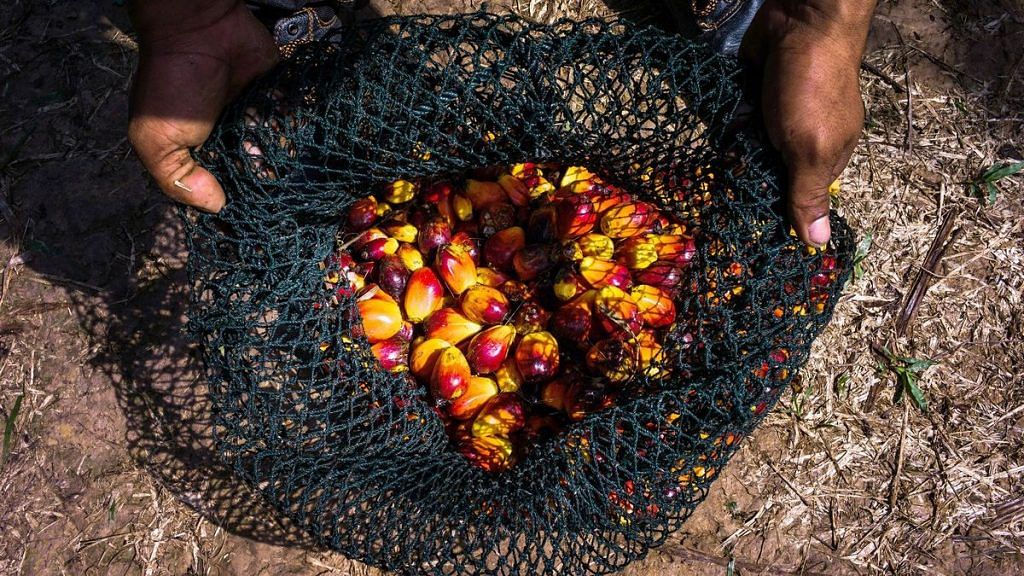New Delhi: With consumer demand dropping, particularly as the restaurant sector has taken a hit in the lockdowns induced by the second Covid-19 wave, the prices of palm oil may finally witness a decline in India.
Palm oil is vital to a number of sectors in the country as its usage is diverse, from cooking oil, pizza dough, soap, shampoo, lipstick, chocolate and even biodiesel.
Palm oil prices hit a record high in the first half of this year but edible oil traders say they are witnessing a decline in demand, which could hit prices and imports.
Its imports were expected to stand at an average of 8,50,000 metric tonnes a month in May and June but now industry officials estimate imports could come down to around 6,50,000 metric tonnes per month.
“The price of palm oil might decrease for the next few months until the country completely recovers from Covid and lockdown. This is because major consumption of palm oil is in the commercial sector in food or other products, demands of which have crashed substantially due to lockdown. This, in turn, will deflate the prices,” said Rahul Chauhan, the agro commodity analyst at Igrain India, a leading commodity market research firm.
Chauhan said the months preceding the second Covid-19 wave saw palm oil prices peak in the country.
“The prices of palm oil have reached their highest levels in the last few months and will not go further above even if the country opens up,” Chauhan added. “Malaysian palm oil saw a never before peak of 4,000-4,500 ringgits/metric tonne (between Rs 70,000-80,000/ metric tonne) from the average of 2,000-2,500 ringgits/metric tonne (Rs 35,000-40,000/metric tonne).”
As Vanaspati, it is the most common cooking medium in the commercial food industry. The total domestic consumption market share for palm, soybean, and sunflower oil stands at 42 per cent, 22 per cent, and 12 per cent respectively.
According to the United States Department of Agriculture (USDA), almost 65 per cent of the total demand for edible oil in India (food and industrial use) is met through imports.
Also read: Onion prices could make you cry again, a surge is expected before Diwali
Record prices before second Covid wave
According to reports, before the second Covid-19 wave struck the country, India’s palm oil imports in March jumped 57 per cent year on year.
As palm oil prices doubled compared to last year, the price of commodities related to it also increased. Since January this year, the price of Godrej No. 1 and Cinthol soap, in which palm oil is a major ingredient, has witnessed a 5-7 per cent price hike.
Moreover, the retail price of palm oil and its popular cooking oil version, Vanaspati, also increased. According to data with the consumer affairs, food, and public distribution ministry, the average retail price of Vanaspati increased by over 50 per cent to Rs 147/kg on 8 May from Rs 92/kg on the same day last year. Similarly, the average retail price of palm oil has surged to Rs 135/kg from Rs 87/kg in the same period.
“As per the sustained demand due to high prices of other edible oils such as soy and sunflower oil, palm oil import was expected to touch as high as 8,30,000 metric tonnes to 8,65,000 metric tonnes for May-June,” Bhavit Shah, an palm oil trader in Mumbai told ThePrint. “However, with lockdown extension and night curfew in major cities, the major source of demand from buyers such as restaurants, ice cream manufacturers and food outlets have crashed leading to a dip in import by at least 2,00,000 metric tonnes.
“With the sustained dip in demand from India and subsequent reduction in import of palm oil, the prices of palm oil will also cool down in the coming days,” Shah added. “This, in turn, will reduce the prices of every product related to it.”
‘Too early to predict price plunge’
Some industry experts, however, said it might be too early to predict a major price plunge and that palm oil may still surge to record high prices.
Malini Saba, founder and chairman of Saba Group, which also deals in palm oil, told ThePrint, “Covid-19 affects the palm oil prices by directly affecting production and demand, creating supply chain and market disruption. Price of commodities depends on several factors that are unpredictable in current times and hence we should not speculate.
“India should slowly see a respite from Covid after June,” Saba added. “Thereafter, we will see how things move.”
(Edited by Arun Prashanth)
Also read: Chicken or egg? Doesn’t matter, neither is really selling well since Covid hit India
